Biblical History of King Solomon's Temple
by Rev. David Hamilton of Mishkan Ministries
The Meaning of Masonry
In all the rich symbolism of Ancient Craft Masonry two symbols,
or symbolic themes, predominate. One is the "Search for Light"; the other is the
"Labor of Building". The source of light is the Holy Bible, and the grand
representation of the builder's art is King Solomon's Temple. Searching
persistently and building carefully, the candidate travels slowly towards the
East. As he pursues his quest for light and more light and still further light
in Masonry, he learns by the way to use the working tools of the stone
craftsman, until at last he finds himself portraying the character of the
greatest of all legendary builders, the master architect of King Solomon's
Temple Hiram Abiff. Searching and building, light and the Temple, - the two
dominant Masonic themes are distinct but not separate, complementary rather than
supplementary.
And the search and the labor are not completed by the candidate
within the Lodge. Light is revealed, and the sacred source of all light is
clearly indicated, but the search for complete illumination must be eternal. The
Temple in the Masonic ritual is almost but not quite completed; the allegory
rises from a physical to a spiritual Temple; "a house, not made with hands,
eternal in the heavens." Regardless of symbolic revelations in Masonic degrees
apart from the Lodge, the unending search and that labor toward perfection,
begun in the Lodge, must continue with the initiated Mason throughout his life.
The Tradition of Solomon
It was natural that imaginative stone Mason's, long before the
development of anything like our modern fraternity, should have felt a kinship
with the great builders of all ages. It was natural also that they should have
acknowledged a peculiar attraction for the most famous and glorious of all
building enterprises, King Solomon's Temple and Citadel. Interest and attraction
for the wonderful structure on Mt. Moriah have increased rather than diminished
during the six hundred and more years of recorded Masonic history, until today
the Temple of Solomon is the spiritual home of Freemasonry. What do we know
about the Temple, its form, its beauties, its historical and religious
background?
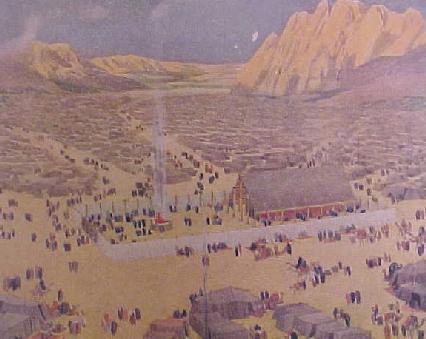
The Tabernacle in the
Wilderness
A thorough understanding of the details of the primitive
Tabernacle of Israel is essential to grasp fully the fundamental principles
involved in the construction of King Solomon's Temple. An intimate knowledge of
the Tabernacle's contents and their relation to one another is necessary to
comprehend the ritualistic system developed by Solomon and his priests. A study
of the ceremonies, the sacrificial offerings, and the priestly ministrations of
the Tabernacle will reveal the great spiritual mystery of the Indwelling God, as
made manifest by Moses during the sojourn in the wilderness.
Master Builders
Moses, during his prolonged stay of forty days and forty nights
on Mt. Sinai, appears to have visualized the form which the Tabernacle should
take. The subsequent building of the Tabernacle, the system of worship adopted,
and the structure of government developed by Moses under divine guidance, have
inspired his race and impressed the whole of mankind. Moses chose as his chief
architect, Bezaleel, a direct descendant of Terah, one of the master builders of
Ur of the Chaldeans, and as chief assistant, Aholiab, also a direct descendent
of Terah and by marriage of the line of Tubal-cain, traditionally the first
instructor of artificers in brass and other metals. Bezaleel was unusually
endowed with the Spirit of God in wisdom, understanding and knowledge. These
three outstanding geniuses gave to the world the most beautiful and magnificent
religious structure ever conceived and erected for a nomadic people.
Exodus 24-31; Genesis 4:22.
Materials for the Tabernacle
Gold, silver, brass, and iron; silks, fine linen and a fabric of
goats' hair; rams' skins, and badgers' skins; shittum wood or acacia timber;
onyx stone, sardius, topaz, carbuncle, emerald, sapphire, diamond, ligure,
agate, amethyst, beryl and jasper; also blue, purple and scarlet dyes; all of
these went into the construction of the Tabernacle. Exodus
25:3; 35: 5-10.
How the Materials were
Acquired
The Israelites, a nomadic tribe roaming about through Chaldea,
Assyria, and Caanan. and finally locating in the land of Goshen in Egypt,
naturally accumulated wealth by trading with the natives through whose countries
they passed. They increased their flocks through attention and by seeking the
well-watered localities for pasture. They industriously converted the wool from
the sheep, and the hair from the goats and camels, into cloth, and wove grass
fibers into fabrics, from all of which they made tents, rugs, clothing, and
other useful articles. But, possibly, their greatest wealth was acquired just
before they left Egypt, when we are told that they "spoiled the Egyptians"
Exodus 11: 2, 12: 35-36.
Now, when the Lord spoke through Moses, requesting an offering
from every man who would give with his heart and in accordance with his means
for the building of the Tabernacle, the people responded with gold, silver,
brass, blue, purple, and scarlet, and fine linen; goats' hair, rams' skins,
shittim wood, oil, spices, sweet incense and precious stones. In addition, every
wise hearted among them gave personal services as needed. So great was their
response that Moses finally gave commandment, saying: "Let neither man nor woman
make any more work for the offering of the Sanctuary." So the people were
restrained from bringing more wealth.
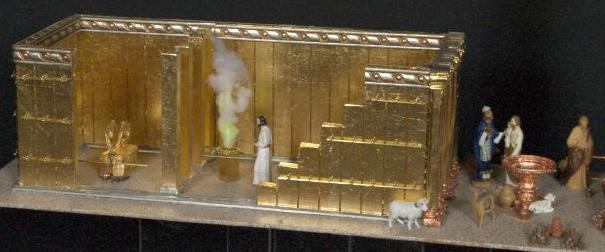
The Architecture of the
Tabernacle
The Tabernacle, Tent, or Portable Temple, being so constructed
that it could be readily taken down, moved from place to place, and erected at
will, was especially adapted to the needs of a nomadic people. Being constructed
on geometrical and scientific principles, it readily lent itself to a practical
system of removal and erection which was essential in the case of so large and
costly a structure. The Tabernacle consisted of an oblong or rectangle, called
the Court, in the rear half of which was the tent or covering of the Sanctuary.
Under this Tent, the Holy and Most Holy Places were defined by partitions of
boards and pillars, securely joined by means of rods, rings, etc. A careful
study of the entire structure reveals an architectural gem, servicably
conceived, beautifully designed, mystically embellished, celestially canopied,
and inspiring the beholder with profound reverence and peaceful security in the
thought of an ever present and Indwelling God, and typifying the encampment of
the Angels of the Lord around about them that fear Him.
The Court of the Tabernacle
The Court, the walled curtain of which surrounded the enclosure
containing the Holy and Most Holy Places, with their furnishings - the Tent,
Laver, Altar of Sacrifice, bowls and other sacrificial utensils - was oblong in
shape; "100 cubits long and 50 cubits wide" (200 feet by 100 feet - A cubit was
a Standard of measurement adopted by ancient builders, the distance from the
elbow to the end of the middle finger.) Exodus 27: 9-19;
38: 9.
This court was enclosed by a wall "5 cubits high" (10 feet),
composed of linen and canvas, supported by pillars of brass, which rested in
sockets of brass. The pillars were ornamented at the top with capitals of
silver, to which were attached hooks of silver to hold in place the rods. The
rods kept the pillars an equal distance apart and supported the canvas or linen
wall. This wall was further supported by guy ropes attached to pins driven into
the ground on both sides. This enclosure, composed of 60 pillars of brass,
filleted with silver, with their 60 capitals of silver, 60 sockets of brass, and
120 hooks of silver, was only broken on the eastern side by the entrance, which
was "20 cubits wide" (40 feet). This entrance, or gate curtain, was of fine
twined linen, wrought with needle work in the most gorgeous shades of blue,
purple, and scarlet. One can visualize its appearance and effect as it stood in
the midst of the encampment of Israel.
The Altar of Burnt-Offering
The Altar stood in the midst of the eastern half of the oblong
Court enclosure, the sacrificial tables and utensils being upon the left of the
main entrance within the Court. The Altar of Burnt-offering was the instrument
used for the purpose of reconciling man with his Maker. The Altar was 5 cubits
long, 5 cubits broad and 3 cubits high (10 feet by 10 by 6). It was a large
hollow case, made of shittim wood, overlaid with brass, and ornamented with huge
wooden horns overlaid with brass, one for each of the four corners.
A grating or network of brass, having a ring at each of its four
corners, was hung in the middle of the top of the Altar, and on it was laid the
wood for the fire which consumed the sacrifice. On two sides of the Altar were
rings of brass, through which were laid staves of shittim wood overlaid with
brass, to carry it from place to place. The pots, shovels, basins, flesh-hooks
and fire pans, as well as all other vessels or utensils necessary to the service
of the Altar, were made of brass. Exodus 27: 1-8; 38:
1-7.
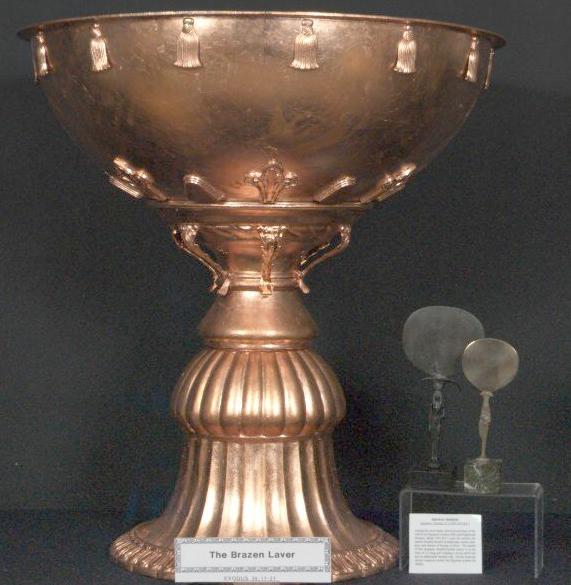
The Brazen Laver
The Laver consisted of a large bowl or fountain, which held
fresh water used by the priests in the services. It stood in a fount, or pool,
as a base to catch the waste water. Here the sacrifices were washed and the
priests cleansed before entering the Tabernacle. From the mention of the "Laver
and its Foot" one gets the idea of two containers, like a cup and saucer.
Exodus 30: 1-8; 38: 1-7.
The Biblical statement that the Laver was made of the looking
glasses of the women of the congregation which assembled at the door of the
Tabernacle, reveals the deep religious emotion which prevailed.
The Sanctuary in the
Tabernacle
The Sanctuary was erected in the center of the western half of
the oblong Court enclosure, and consisted of two chambers, the Holy Place and
the Most Holy Place. The tent, or covering, protected and formed a cover round
about the Sanctuary, and was used by the priests and attendants as chambers or
rest rooms.
The western end and the two sides of the Sanctuary were enclosed
by boards made of shittim wood overlaid with gold. The length of one board was10
cubits (20 feet), and the breadth was 1 1/2 cubits (3 feet). Each board had two
tenons at the base equally distant one from the other, with two sockets of
silver for each board to fit the tenons and form the foundation. On the outside
of each board were rings to receive the bars to join one board to the other.
There were 20 boards for the north side and 20 boards for the south side, held
in place by five bars for each side. Four bars joined in the center of the wall
and one bar passed through all the rings of the 20 boards, on each side. For the
western end of the Sanctuary there were six boards and twelve tenons, with two
corner boards and four tenons. They were so cut and coupled together as to form
a perfect right angle for each corner, coupled at top and bottom. All the boards
stood upright, edge to edge.
The Most Holy Place was divided from the Holy Place by four
pillars of shittim wood overlaid with gold, resting upon sockets of silver.
These pillars supported a hanging of most sumptuous tapestry of fine twined
linen, a splendid fabric in blue, purple, and scarlet, beautifully embroidered
with cherubim in gold.
A most beautiful covering of splendid linen fabrics in blue,
purple, and scarlet, embroidered with figures of cherubim in gold formed the
canopy for the two sacred rooms. This, together with the two hangings previously
described and the boards of gold, produced an enchanting effect in gorgeous
colorings, dazzling beyond description. The covering was composed of ten
curtains of fine linen all in blue, purple and scarlet. Each curtain was 28
cubits (56 feet) long and the breadth of 4 cubits (8 feet). The ten curtains
were joined permanently into two great curtains of five each by means of
couplings. On one edge of one of the great curtains were loops of blue, 50 in
number; on the edge of the other great curtain were taches of gold, 50 in
number. The loops and taches coupled the curtains together into a one-piece
covering. This splendid fabric of blue, purple, and scarlet colored linen,
magnificently embroidered with figures of cherubim, formed the ceiling of both
the Holy and Most Holy Places. It was drawn down on the outside of the golden
boards and fastened to the center rod upon all sides except the eastern
entrance.
To protect this beautiful and delicately wrought covering,
eleven curtains of goats' hair were provided, each 30 cubits (60 feet) long and
4 cubits (8 feet) wide. Five of these curtains were permanently united into one
great curtain and six into another. These in turn were provided with 50 loops on
the edge of one curtain and 50 taches opposite the loops. The two composite
curtains were joined to make one great covering carefully drawn over the entire
Sanctuary and securely fastened on all sides except the eastern entrance. To
complete the protection against inclement weather, a tent, oblong in shape, was
also provided, consisting of two coverings, an inner one of rams' skin, dyed
red, and an outer of badgers' skins. The tent had a ridge over which the
coverings were drawn and then fastened by means of guy ropes to pins driven into
the ground at regular intervals upon all sides.
The Holy Place
This was an oblong room 20 cubits in length, 10 cubits in width
and 10 cubits in height (40 feet by 20 by 20). The entrance gate consisted of a
beautiful tapestry of blue, purple, and scarlet fabric, gorgeously embroidered
with cherubim in pure gold. The tapestry was hung upon five pillars of wood
overlaid with gold, having beautiful capitals of silver and sockets of brass.
The pillars, which were arranged in regular interval across the east entrance of
the room, had hooks at the very top of the
capitals to receive the loops at the top edge of the curtain or veil of the
Tabernacle, which was thus suspended across the entire front at the west so as
to separate the Holy from the Most Holy Place. Above, and forming the ceiling,
was the brilliant colored linen covering, and on the north and south sides were
the highly polished golden walls reflecting in radiant splendor the varied
colored drappings and richly rugged floor.
The Holy Place contained three articles of furniture, the Altar
of Incense, which stood in the center, the Golden Candlestick with all its
vessels, which stood on the left side center, and the Table of Shewbread with
its dishes, spoons, covers, and bowls, which stood on the right side center. The
priests entered the Holy Place each day to offer incense, and to renew the
lights in the Golden Candlestick.
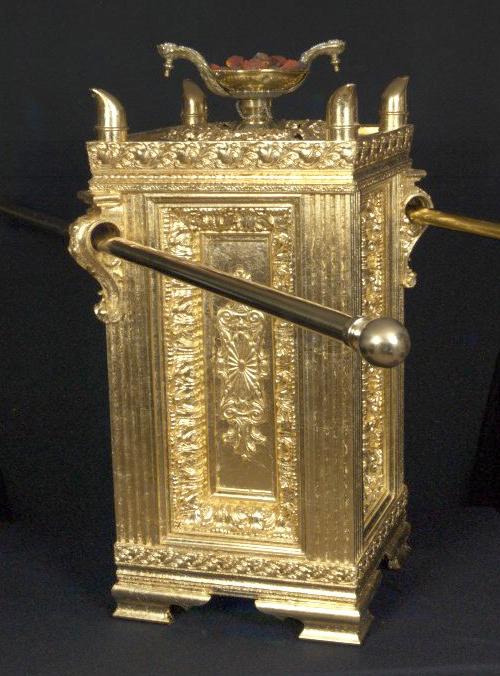
The Altar of Incense
The Golden Altar or Altar of Incense was made of shittim wood
overlaid with pure gold. In form, it was two cubits high and one cubit broad
(four-square, 4 feet by 2) on each of the four sides. Upon the top edge round
about, it was ornamented with a crown of gold of unique design. On the four
corners were horns made of shittim wood overlaid with pure gold, in shape like
unto rams' horns. Under the crown, on each of two sides, were four rings of
gold, two on each side, through which the staves, made of shittim wood overlaid
with gold, were passed. These staves were for carrying it.
Exodus 39: 38. The Censer was placed on the top
center of the Golden Altar, and in it sweet incense was burned every morning.
Exodus 30: 1-10.
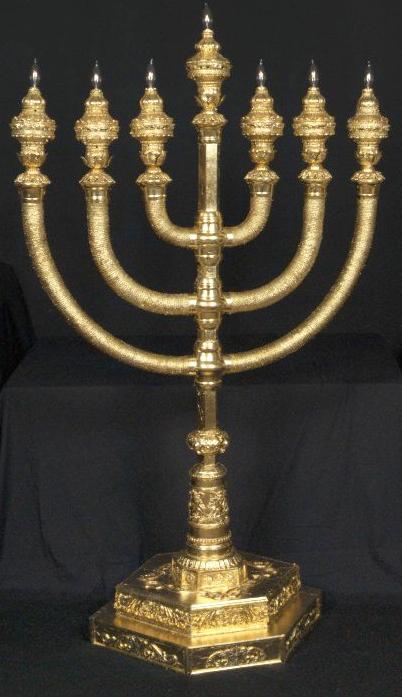
The Golden Candlestick
The Golden Candlestick was made of pure gold of "beaten work"
with a central shaft ornamented with knobs, flowers, and bowls. There were six
branches going out of its sides, three branches out from one side and three out
from the other. All the branches, like the shaft, were ornamented with knobs,
flowers, and bowls. The bowls were made after the fashion of almonds. On the top
of the shaft, and on each one of the six branches, were lamps large enough to
hold sufficient oil and cotton to burn all night. Exodus
26: 31-39; 37: 17-24.
The Biblical text does not define the height or breadth of the
candelabrum. However, proportionate harmony with the rest of the furniture
would suggest a height of 3 cubits (6 feet) and a breadth of 2 1/2 cubits (5
feet).
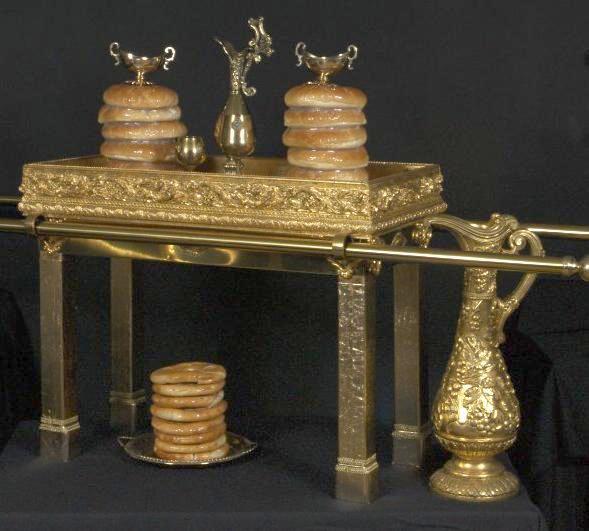
The Table of Shewbread
The table was made of shittim wood overlaid with pure gold 2
cubits long, 1 cubit broad and 1 1/2 cubits high (4 feet by 2 by 3) and
finished, like the Altar, with a crown or rim of gold round about at the top
edge, and four rings and two staves with which to carry it. It was furnished
with dishes, spoons, bowls, and covers, all of pure gold.
Exodus 35: 23-30; 37: 1-16.
Upon this table were placed twelve cakes of fine flour, in two
rows, six in a row, called "Shewbread." "And thou shall set upon the table
Shewbread before me alway." Exodus 25: 30.
The Most Holy Place
The second or inner chamber, called the Most Holy Place, was 10
cubits (20 feet) on each side and consequently a perfect cube. It contained the
Ark of the Covenant, in which were the two Tables of Stone. This place, the Holy
of Holies, the most sacred portion of the divinely appointed structure, was
surrounded on three sides by highly polished walls of pure gold. The "Veil" of
fine twined linen in blue, purple, and scarlet, richly embroidered and
ornamented with figures of cherubim in gold, hanging from the tops of four
pillars of shittim wood overlaid with pure gold, and resting in sockets of
silver, defined the eastern and only entrance. Over all this magnificent,
foursquare, resplendent place hung the blue, purple, and scarlet curtain, richly
embroidered with golden cherubim. The reflection of these brilliant hues, and of
the Cherubim, upon the walls of polished gold, must a produced have weird,
startling, awe-inspiring and overpowering effect upon all those who were
ordained to enter this most sacred place. Within this enclosure there was but
one article of furniture and its contents, that is, the Ark of the Covenant
containing the Testimony.
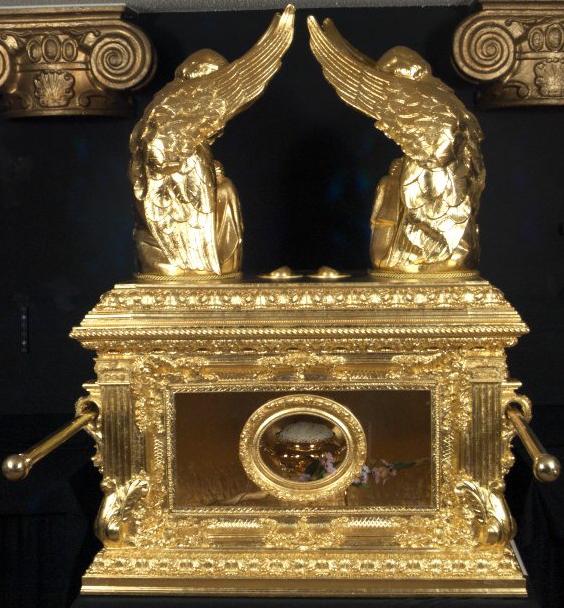
The Ark of the Covenant
The Ark of the Covenant was an ark or chest of shittum wood two
and one-half cubits long, and one and one-half cubits high (5 feet by 3 by 3)
overlaid with gold, and embellished with a crown of gold extending around the
chest upon the top edge. Four rings of pure gold were set in the four corners,
two on one side and two on the other, through which were passed the wooden
staves overlaid with gold used in carrying the sacred chest.
Exodus 25: 10; 37: 1-10.
The lid, or covering was the Mercy Seat, and was one piece of of
pure gold, two and one-half cubits long and one and one-half cubits broad (5
feet by 3). Upon each end of this Mercy Seat were Cherubim, made of pure
"beaten" gold. These cherubim stretched forth their wings on high, so as to
cover the Mercy Seat, their faces being inward toward the Mercy Seat. In this
Ark, or Chest, and directly under the Mercy Seat, were the most sacred religious
items of Judaism which included the Testimony or Ten Commandments upon two
tables of stone, Manna from Heaven and Arron's Rod.
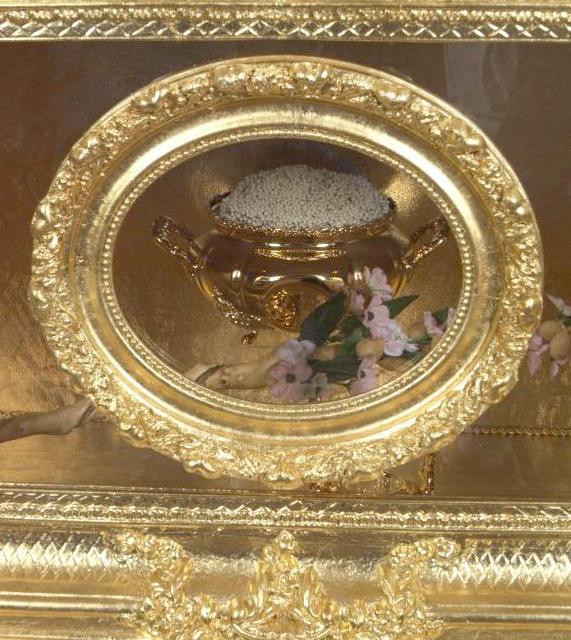
The Ark of the Covenant, thus fittingly enshrined, was the only
piece of furniture in the Most Holy Place. It was visited but once each year by
the High Priest, on the Day of Atonement, to make "atonement for the sins of the
people." This was the most solemn ceremony of the Hebrew worship.
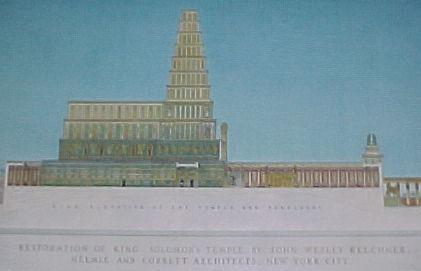
King Solomon's Temple and
Citadel
The comprehensiveness of the Tabernacle, its hidden grandeur,
and its mysterious splendor, appealed to David to such an extent that he longed
to build, with the Tabernacle as a model, a permanent Temple dedicated to the
worship of the true God. David loved the Tabernacle as the house of the Lord. He
desired to dwell in its courts forever, that he might behold the glory of God,
make manifest His eternal presence, and sing His praise. David had the
Tabernacle ever in mind when he prepared plans and patterns for the Temple to be
erected upon Mount Moriah, the most sacred spot on Earth. He bequeathed the
plans to Solomon, who with the Tabernacle as a guide, erected a Temple the
grandeur of which has so impressed the world that men, never tiring in its
praise, have placed it foremost in legend, romance, history, and religion.
The Tabernacle was the pattern which guided the master builders
in the construction of King Solomon's Temple, as well as the priests in its
ritualistic services. The physical Temple was completed about 1005 B.C.
according to the received chronology. 1 Chron. 28:11-21.
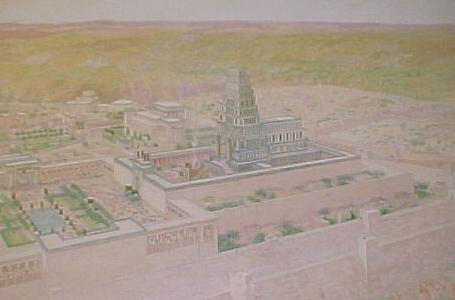
Location of the Temple
Mount Moriah, in the days of Abraham, was one of the hills in
the vicinity of Salem, the one chosen by Abraham upon which to sacrifice his
only son Isaac "as a burnt offering" unto the Lord. In later years it came under
the control of the Amorites, whose principal city, Jebus, occupied a hill
westward from Moriah. Genesis 22: 2.
In the days of King David, who subdued the Jebusites, it became
a part of the city named Jerusalem. It is 14 1/2 miles from Jordan, 15 miles
from Salt Sea, and 41 miles from the Mediterranean. The location was not the
most desirable one on which to erect the Temple, but was chosen by Solomon
because of its sacred associations. It was fitting that the great Temple to be
dedicated to the God of his fathers should be erected upon the very spot where
Abraham made manifest that faith in Him which was accepted ever after by the
children of Israel and the world. On this spot also, where Abraham offered
Isaac, David made an acceptable offering unto the Lord, and by faith saved
Jerusalem from destruction. David no doubt realized the significance of the name
given to the Mount by Abraham, "Jehovah Sees," and ever after the children of
Abraham found consolation in the thought, "In the Mount of Jehovah He will be
seen." Solomon, in deciding to erect the Temple upon this sacred spot, fulfilled
the wishes of his father, King David, and of all in whose breasts these
sentiments were cherished. "Beautiful for Situation, the Joy of the whole
Earth."
Materials for the Temple
"Gold for things to be made of gold; silver for things of
silver; brass for things of brass; iron for things of iron; wood for things of
wood; onyx stones and stones to be set, glistening stones of diverse colors, and
all manner of precious stones, and marble stones in abundance." Nails of gold
were used, and nails of brass and iron; chains of gold; ivory from Ophir; hewn
stones, stones sawed with saws, great stones (granite), costly stones (marble of
various colorings); cedar wood from Mt. Lebanon, algum wood from Mt. Lebanon and
from Ophir, fir wood, sycamore, shittim wood or acacia, olive wood and palm,
juniper, balsam and mulberry wood. 1 Chron.29:2.
Leather came from ox skins and chamois; fur from goats and
badgers; wool from sheep. Fine (white) twined linen was used, and goats' and
camels' hair made textile fabrics of purple, crimson, and blue. Varicolored dyes
were produced from clays, stones, fish, and vegetation. For the services were
furnished oils, spices, incense, myrtle, fitches, myrrh, sweet cinnamon, calamus,
cassia, stacte, onycha, galbanum and frankincense, - Nature's contributions to
the handiwork of Man.
How the Temple Materials were
Acquired
King David, one of the world's greatest generals and statesmen,
founded an imperial dominion which theretofore had not been realized, though it
had been promised to Abraham. David became King on the scale of the great
sovereigns, demanding and receiving tribute, and forming alliances which enabled
him to control the great trade route of which Jerusalem was the center. Yet,
during the turmoil and struggles attending his rise to supremacy, he never
ceased to make preparation for carrying out his one ambition, that of erecting a
Temple to the worship of God. "Behold in my trouble I have prepared for the
house of the Lord an hundred thousand talants of gold, and a thousand thousand
talents of silver; and of brass without weight, for it is in abundance; timber
also and stone I have prepared," declared David. Again he repeats, "I have
prepared with all my might for the house of my God the gold for things to be
made of gold; and the silver for things of silver; and the brass for things of
brass; the iron for things of iron; and wood for things of wood; onyx stones and
stones to be set, glistening stones, and of diverse colors, and all manner of
precious stones and marble stones in abundance." In addition to the sums he
"prepared" he donated from his own private purse, "three thousand talents of
gold, seven thousand talents of silver," all of which he carefully tabulated and
dedicated to the Lord, in the presence of the fathers and princes of the tribes
of Israel, who stood in awed silence before their venerable and God-fearing
sovereign. Genesis 15: 18-21.
In his final and supreme effort to arouse his hearers to respond
with contributions of their own, David shouted: "Who then is willing to
consecrate his service this day unto the Lord?" "Then the chief of the fathers
and princes of the tribes of Israel, and the captains of thousands and of
hundreds, with the rulers of the king's work, offered willingly of gold, five
thousand talents and ten thousand drams, and of silver ten
thousand talents, and of brass eighteen thousand talents, and one hundred
thousand talents of iron. And they with whom precious stones were found gave
them to the treasure of the house of the Lord." 1 Chron.
29.
Hiram, King of Tyre, the friend of David, gave Solomon cedar,
algum and fir trees according to all Solomon's needs, also great stones
(granite), costly stones (marbles), and hewed stones, shaped for pillars and
squared by stone squarers.during the course of the construction of the Temple,
King Hiram and King Solomon caused periodical trips to be made to Ophir for
gold, algum trees, and precious stones to add to the apparently inexhaustible
store. "King David rejoiced with great joy." Hiram, King of Tyre, "blessed the
Lord God of Israel, that made heaven and earth, who hath given to David the King
a wise son, endowed with prudence and understanding, that might build an house
for the Lord."
Co-operation of Allied
Nations
King David was thirty years old when the elders of Judah called
him to the City of Hebron, gave him their allegiance, and publicly anointed him
King. Seven years later, he received the allegiance of the entire nation. He
then began to build the empire of his dreams, as promised to Abraham, which was
to be the glory of Israel and the world. His first act was to set up the
Tabernacle in the New City, restored, embellished, and unequalled for permanence
and beauty. All his thoughts were for the religious interests of the people.
Although he was recognized as "a man after God's own heart," he was not perfect.
He was a man of great stature, a physical giant, a mighty warrior, and a great
general, "every inch a King," a shrewd politician and sagacious statesman. His
outstanding political act was the seizure of the city of Jebus, the key to
control of the great trade route between the East and West, which he called
Jerusalem. This also gave him possession of the most sacred spot on earth, Mount
Moriah.
The commanding position of his capitol brought the Phoenicians
into an alliance, and "Hiram, King of Tyre, sent messengers, and cedar trees,
and carpenters, and masons, and built David an house (palace)." Realizing his
strength, David fought and conquered the Philistines, thus making a trade
alliance with Egypt possible. Having made these alliances, he was free to turn
his victorious armies eastward. There he conquered the Moabites, who "became
David's servants and brought gifts." He next conquered the Zobahites, which
brought him into battle with the Syrians, whom he utterly routed and thus gained
control of Damascus and part of Syria. The spoils of these wars were great; he
received much gold, silver and brass, besides placing the Syrians under
allegiance, so that they too "became servants to David, and brought gifts."
Having conquered the Syrians, Moabites, Ammonites, Philistines, Amalekites,
Rehobites and Hittites with his thirteen hundred thousand fighting men, he
forced tribute, withstood all enemies, and raised his kingdom to superior
strength, opulence, and splendor. Having built an empire unequalled in his time
and established peace with the world, he bequeathed to his son, Solomon, untold
wealth, a commanding army, a multiple allegiance, a vast empire, and sympathetic
international accord.
Through his energy, shrewdness, skill, unusual fairness,
generosity, and devotion, he also left to his heir an affectionate people. "Now
the days of David drew nigh that he should die, and he charged Solomon his son."
This dying charge, a magnificent state paper and one of the most remarkable
readings in the Bible, related principally to the building of the Temple, whose
erection David had not undertaken because of wars. "So David slept with his
fathers and was buried in the City of David." 1 Kings 2; 1
Chron. 28, 29.
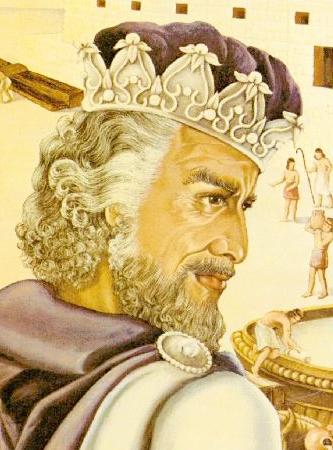
Solomon, King of Israel
Solomon was the son of Bath-sheba, a direct descendant of
Ishmael, whom Hagar bore unto Abraham. David, through the house of Judah, was a
direct descendant of Issac. Thus, the two great families founded by Abraham were
united in Solomon. He was about 14 years old when he was anointed King of Israel
in Gihon, and about 21 at the death of David, so that when he was fully
established on the throne, he was familiar with the elaborate designs and
abundant preparations of his father for the building of the Temple. Solomon,
having been carefully nutured by his God-fearing queen mother, had grown into a
young man of great mental vigor. Having been schooled under the greatest masters
of the times, reared in one of the richest and most brilliant courts of the then
known world, he was preeminently gifted for the stupendous task before him, and
undertook with enthusiasm to carry it on. The secret of Solomon's success is
faithfully portrayed in his request at the time the Lord appeared to him in a
dream, and asked what he (the Lord) should give him. Solomon's request was "for
an understanding heart" that he might "discern between good and evil," that he
might know how to walk before his people. This submission to God, this desire to
have God make manifest through him the righteousness of God, was the first
indication of his future greatness. He gathered about him the wonders of Nature,
both of animal and vegetable life, drew from them the secrets of their
existence, and learned that God was made manifest in the heavens above and in
the earth beneath, and that God was all and in all. He soon set about to fulfill
the wishes of his father and to glorify the God of his dream by creating a
Temple, monumental in design, exceedingly magnificent, and peculiarly fitted to
amplify the mysteries of Godliness. He took counsel with his wise men, held
conference with his allies, and sought out master builders from all great
nations. Thus equipped, he laid the foundation and carried to completion the
Temple, not only as a place for worship, but as a structure of dazzling
architectural glory.
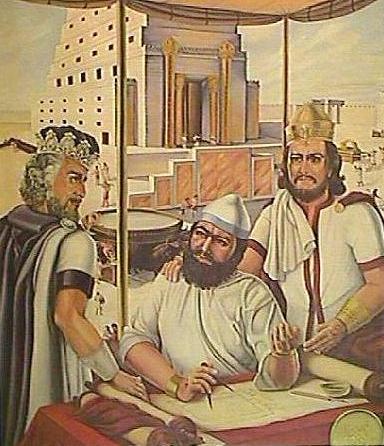
Workmen at the Temple
Hiram of Tyre, the principal architect and engineer, was of
mixed race. "He was a widow's son of the tribe of Naphtali, and his father was a
man of Tyre." He was "skilled to work in gold and in silver, in brass, in iron,
in stone, and in timber, in purple, in blue, and in fine linen, and in crimson;
also to grave any manner of graving, and to find out every device which shall be
put to him. Cunning, a man richly endowed by Nature in wisdom and knowledge, he
was preeminently fitted for this almost supernatural task. With him were
associated the trained and "cunning" men of David, who had "trained workmen in
abundance, hewers and workers of stone and timber." 1
Kings 7: 13-14.
"Solomon numbered the strangers that were in the land of Israel,
and they were found an hundred and fifty thousand and three thousand and six
hundred." He set three score and ten thousand of them to be bearers of burdens,
and four score thousand to be hewers in the mountain. In addition, Solomon
raised a levy out of all Israel of thirty thousand men, which he sent to
Lebanon. Over this great army of workers, in order to obtain the greatest
efficiency and results, he set three thousand six hundred overseers, besides the
chief of his officers, which were over all the work. 2
Chron. 2: 17-18.
Solomon having married a daughter of Egypt's king, and thus
cemented his alliance with that powerful monarch, and having, at the same time,
a workable trade pact with the Phoenicians, drew from these nations skilled
workmen to assist his already well-trained and formidable force. In addition,
nearly all the neighboring nations as well as those of more distant realms were
drawn upon for builders and artisans skilled in wood, metal, and stonework.
1 Kings 5: 18.
Architecture of the Temple
The assemblage of the world's architectural genius at Jerusalem,
and the amassed store of materials of gold, silver, brass, iron, granite, and
marble, together with the precious stones and costly woods and fabrics brought
from foreign shores, resulted in a structure distinctive in design, gigantic in
proportions, and glorious in embellishments, the like of which Israel and the
people of that day had never before seen, and which will never again be equaled,
much less excelled. The Temple and the Palace together, as a unit, consisted of
a series of terraces round about Mount Moriah, the highest point of which was
crowned by the Great Porch, with the Holy and the Most Holy Place.
The second highest terrace, surrounding the Mount, was an oblong
or rectangle, 1,600 feet long and 800 feet wide, having a retaining wall rising
from the base of the Mount to a height of from 80 to 240 feet as conditions
required for support, for defense, and to produce a uniform raised level about
the Mount. Within this first enclosure the architects provided homes for the
porters and singers, as well as havens for the worshipers. The upper terrace was
800 feet long and 400 feet wide, surrounded by a retaining wall of great stone.
The eastern half of this second enclosed terrace or court was embellished by
three rows of hewed stones or pillars, round about, forming a colonnade and
supporting an entablature of cedar beams and costly stones. The Covert for the
King was located on the north side and was of solid brass. In the western half
of this oblong enclosure, and on the north side, was the Court for the women,
surrounded by high walls and enclosing a series of chambers suitably arranged.
To the south was the Court of the Priests, containing the chambers for those who
were actively engaged in the Temple services. In the center of the western half
of the great court was the inner court, 400 feet by 200 feet in size, in the
form of a rectangle, surrounded by a cloistered colonnade of three rows of
pillars supporting a beautiful entablature of cedar beams and costly stones. The
only entrance to the inner court was through the Great Gate on the eastern side.
In the center of the eastern half of the inner court stood the Great Altar of
Burnt-offering. In the southeast corner was the Molten Sea, and on the north and
south sides, five on each side, were the Lavers. The western square of the inner
court contained the House, or Holy and Most Holy Places, surrounded by a series
of chambers. The approach to these sacred precincts was through the Great Porch,
rising to a height of 240 feet.
These crowning terraces which supported the Temple and King
Solomon's Palace or Citadel, including his house, the House of the Forest of
Lebanon, the Queen's Palace, the Porch of Pillars, and kindred structures, were
surrounded for the sake of security by a wall which began at the bottom of the
Mount. Some of the sides of this wall were reared 280 feet in height before they
attained the desired level, and these massive and curious bases, together with
the super-structure, formed an impressive prospect, which was the marvel of all
beholders. 2 Chron. 3: 4.
Approaching the Temple terraces from the southwest was a road
leading through a gate into the great citadel, within the walls of which were
the numerous buildings. The citadel was on an elevation just below that of the
Temple, and visitors to the latter had to pass through the former. Here were the
King's Palace, the House of the Forest of Lebanon, the Porch of Pillars, the
Queen's Palace, the Tower of David, the Palace of the Captain of the Host, the
Palace of the High Priest, and the Judgment Seat or Throne. Within this same
enclosure were to be found the homes of the Royal Harem, and of the immediate
official family and attendants. Here also were the Royal Gardens in which were
to be found a great variety of trees and beautiful shrubbery, and enclosures for
wild and domestic animals and birds.
The King's Palace, the House of the Forest of Lebanon, and the other royal
buildings were of a size and magnificence such as Israel had never seen before,
and were prized because they reflected the high political rank of the nation, as
the Temple reflected the glory of its religious institutions. The road from the
southwest gate ran diagonally northeastward to a central square which was
dominated by the Tower of David. At the south of the square was the Court of
Guards, at the west of the Queen's Palace, and at the east the Palace of King
Solomon.
The Banquet Hall in the
Palace
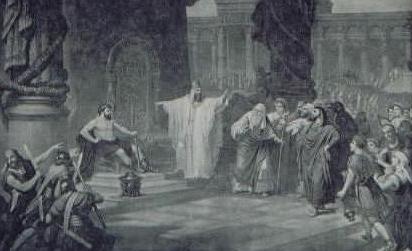
A banquet in King Solomon's Palace presented a scene of
unparalleled magnificence. Here royal visitors, including the Queen of Sheba,
were given sumptuous entertainment. Here also, according to tradition, the
humble iron worker assumed the place of honor at a banquet celebrating the
completion of the Temple, - to the consternation of the other guests but with
the approval of the wise King.
The Palace of the Queen
It is stated that he built her "an house"; by that we understand
that he meant it was a palace, in style Egyptian, where she could enjoy the
music from her native land, isolated, as it were from Israel. Above all the
women that surrounded Solomon, it is said that the only one that he really loved
was his wife, the Queen; and so ardent was his love that she was able to draw
him from the worship of his God and the God of his fathers.
The Porch of Pillars
North of the Queen's Palace was the famous Porch of the Pillars.
This monumental structure was erected in honor of the Princes of Milo and was
considered the most beautiful entrance to the Citadel of King Solomon. A famous
picture portrays a Prince from Milo being received at this great portal.
Important visitors such as Kings, Governors, Potentates and others of national
and international standing, whom the King delighted to honor, were received at
this Gate. The Porch of Pillars consisted of thirty-two pillars, beautifully
entabulatured, resting upon a foundation or platform one hundred feet long and
sixty feet wide. 1
Kings 7: 6.
The Porch of Judgment
Directly to the east, across an open space, was the Great Porch
of Judgment. The Bible portrays a momentous event. Solomon is on his throne; at
his right is his life-long friend, Zabod, and on his left, a scribe; immediately
in front of the scribe is the High Priest; on the steps an orator, presenting
the complaints of the Princes of the Tribes of Israel. On the right, in front of
the throne, a Prophet of the Desert, dressed in leopard skin and carrying a
sheppard's crook. So important was this meeting, that Solomon called out his
personal bodyguard. "He is being condemned by this Prophet as having wandered
away from the faith of the true God; he is being condemned by the Princes as
having squandered money in riotous living, over-taxing the people, causing
universal complaint, and threats of secession from the House of Judah."
1 Kings 7: 10, 18, 19, 20.
The House of the Forest of
Lebanon
Northward, extending almost to the wall of the Temple terrace,
was the monumental House of the Forest of Lebanon. In the foreground were the
elaborate and beautiful sunken gardens. Upon the right and left of this
building, enclosed by entablatured walls, were the international bazaars and
shops.
The Inner Court of the Temple
The avenue from the southwest gate of the citadel, having passed
the Palaces, the Porches, and the House of the Forest of Lebanon, proceeded
again northeastward to an open space before the House of the High Priest, where
there was a gate leading upward to the Forecourt of the Temple. This outer court
occupied the whole of the eastern half of the Temple terrace, and on its
northern side was the great brass Covert for the King. At the western side of
the Forecourt was the gate to the Inner Court, whence rose the facade of the
Temple itself.
The Altar of Burnt-Offering
In the center of the eastern half of the inner court stood the
most indispensable part of the apparatus of worship, the Altar of
Burnt-offering, made of brass, "twenty cubits in length, twenty in breadth and
ten cubits in height" (40 feet long, 40 broad, and 20 high).
2 Chron. 4: 1.
The Molten Sea
The inner court, the southeast corner, stood the most striking
of the creations of Solomon's Phoenician artist, Hiram of Tyre. This was the
Molten Sea. It was a large circular tank of bronze, "thirty cubits in
circumference, ten cubits in diameter and five cubits in height" (60 feet
around, 20 feet across, and 10 feet high), with a brim the thickness of a
handbreadth. These measurements show that Hiram understood the principles of
circular form and construction. This great sea rested on the backs of twelve
bronze bulls which, in groups of three, faced the four cardinal points.
1 Kings 7: 23-27; 2 Chron. 4: 2-5.
The Lavers
There were ten Lavers of brass raised on bases resting upon
wheels. They were used for washing the animals to be sacrificed in the
burnt-offering and in the general cleansing of the court after the services.
Each one was "four cubits long, four cubits wide and three cubits high" (8 feet
by 8 by 6). The Lavers, bases, and wheels were highly ornamented, and
symbolically embellished with lions, oxen, cherubim and palm trees. Five of the
Lavers stood on the north side of the inner court and five on the south side.
1 Kings 7: 27-39.
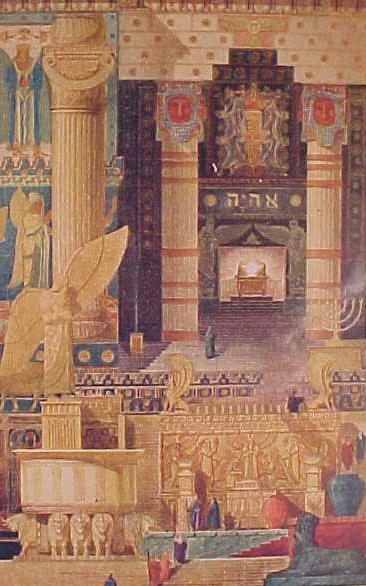
The Great Porch
The Great Porch was a monumental structure "one hundred and
twenty cubits high" (240 feet), built over the entrance to the Sanctuary. This
entrance or vestibule was "twenty cubits long and ten cubits broad" (40 feet by
20). Through this porch the priests were admitted to the Sanctuary.
2 Chron. 3: 4; 1 Kings 6: 3.
The Two Pillars of Brass
These two great bronze shafts, standing in relief, formed an
important feature in the architecture of the Temple. Each one was "thirty-five
cubits high and twelve cubits in circumference" (70 feet high and 24 feet in
circumference). They were highly ornamented by a network of brass, overhung
with wreaths of bronze pomegranates, each row containing one hundred. Upon the
pillars and the top of the chapiters were pommels (great bowls or vessels for
oil) over which were hung, festoon-wise, wreaths of pomegranates, interspersed
here and there with lily work. They bore the names of Jachin and Boaz and were
placed in front of the porch leading to the Sanctuary. 2
Chron. 3:15; 1 Kings 7: 15-22; 2 Chron. 4: 12-13.
The Treasure Room
This room occupied the space above the Holy and Most Holy
Places, extending the entire length of the House. It was "sixty cubits long,
twenty cubits wide and ten cubits high" (120 feet by 40 by 20). Here were stored
the many things King David had dedicated to the Lord. Here also were the silver
and gold vessels and instruments, and all the dedicated things such as gifts
from allied kings, princes, potentates, and all other important personages. It
was also the royal treasury where Solomon deposited and from whence he disbursed
all things of value. 1 Kings 6: 2.
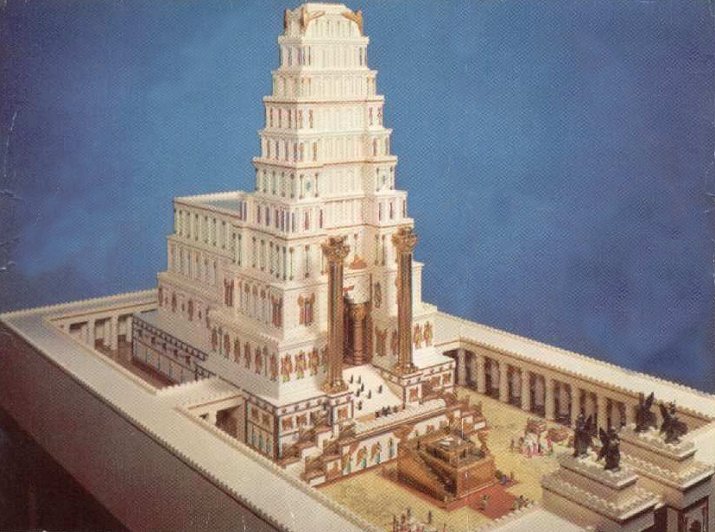
The Chambers Round About the
Temple
A series of chambers surround the house on three sides, the
north, west, and south, all three stories high. The uppermost chamber was "five
cubits," 10 feet broad, the middle one was "six cubits" (12 feet) and the third
or lower chamber was "seven cubits" (14 feet). Access to these chambers was by
means of a peculiar and secret winding stairway on the south side of the house
from the lower into the middle and from thence to the upper chambers. These
chambers were all finished in fine wool and overlaid with pure gold, affording
quiet and secluded spots for secret communion with God and for the preparation
and proper clothing of the priests, as well as storage room for the vessels and
instruments used every day in the ritualistic services. 1
Kings 6: 5, 6, 8, 10.
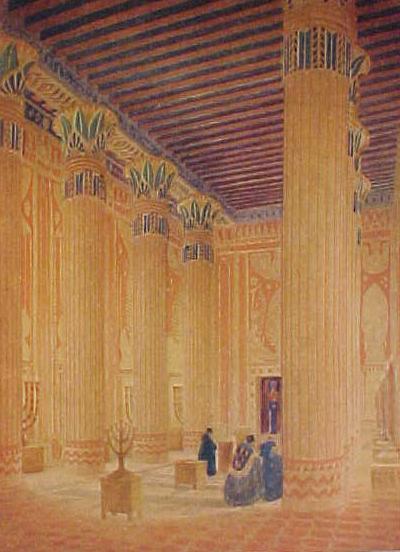
The Holy Place
The Holy Place, or Greater House, was a double cube "forty
cubits long, twenty cubits wide, and twenty cubits high" (80 feet long, 40 wide,
and 40 high), "ceiled with fir tree," overlaid with fine gold and settings of
palm trees and chains, with engraved cherubim on the walls. The entire house was
garnished with precious stones for beauty. The entrance to the house was by a
large double door, two leaves to the one door and two leaves to the other, of
olive wood, carved with cherubim, palm trees, and open flowers, all overlaid
with pure gold.
The furniture of the Holy Place consisted of ten candlesticks of
pure gold, five on the right side and five on the left, together with their
lamps and snuffers; also ten tables with pure gold, five on the right side and
five on the left, together with their bowls, basins, spoons, and covers. To
these must be added the golden altar of incense and its censer, the table of
shewbread, and the golden candlestick of the Tabernacle, all harmoniously
arranged within the walls, ceilings, and floors of gold set with precious
stones. 1 Kings 7: 49; 2 Chron. 4: 8.
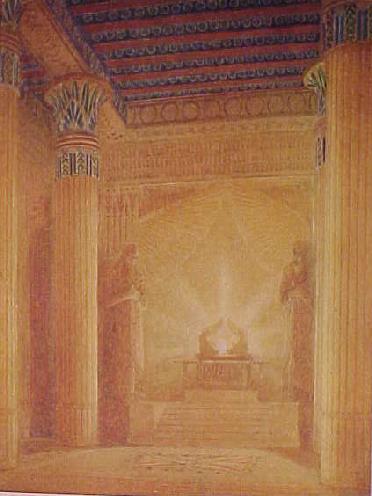
The Most Holy Place
The Holy of Holies was a perfect 40 foot cube "twenty cubits
broad, twenty cubits long, and twenty cubits high." All the walls round about
were carved with figures of cherubim, palm trees, and open flowers, all overlaid
with pure gold; even the floor was overlaid with gold, and all was garnished
with precious stones for beauty. The two doors leading to this Most Holy Place
were of olive wood, cunningly carved with cherubim, palm trees and open flowers,
and overlaid with pure gold. Each door had two leaves which folded. Over this
entrance hung the veil of blue, purple, and crimson of the finest fabric,
cunningly wrought with cherubim, palm trees, and open flowers. This beautiful
tapestry defined the entrance to the Oracle. The only piece of furniture in the
Most Holy Place was the Sacred Ark of the Covenant of the Lord, containing the
testimony. This was the place within the oracles shadowed by the wings of two
gigantic cherubim of olive wood, overlaid with pure gold. Each cherubim was "ten
cubits high" (20 feet) with an outspread of wings of "twenty cubits) (40 feet).
1 Kings 6:23.
The Temple and Early Masonry
History is an afterthought, written only when greatness has
already been achieved. There was no Hebrew history before David, who united the
tribes and conquered their enemies. Nor was there any Masonic history, as we
know it, until the operative stone masons of England had established their craft
by building some of those marvelous monuments to Christian civilization, the
Gothic cathedrals. But there were Masons and there were Hebrews long before
their were books about either. In the widely separated beginnings of both
Hebrew and Masonic history we find references to the building of a Temple. We
have seen that King Solomon's Temple was not built in a day, or without the
accumulation and expenditure of a vast treasure in materials, craftsmanship, and
human organization. We have seen that a generation of intensive preparation
(David concentrating the energies of a kingdom on a project he was never able to
behold) preceded the actual building, and that long ages of venerating the
simpler Tabernacle in the Wilderness came before that.
The Masonic fraternity started simply, too, and the magnificent
brotherly structure of the past two hundred years was many centuries in the
making. Unlike the Temple, the fraternity in its formative years had no powerful
king to protect and support it, and its growth was far less spectacular than
that of the great monument on Mount Moriah.
The Temple and Eternity
King Solomon's Temple was the perfect architectural expression
of the religious faith of a people. As such, it has never been equaled in the
history of the world, much less excelled. Its actual life was short, but is
influence has been incalculable. Built to endure for centuries, only a few years
elapsed before it was desecrated and then completely destroyed by invading
armies. Yet its fame did not die. The children of Israel, with fervid
determination, rebuilt it twice, and twice more it was destroyed. The
descendents of its builders were scattered far and wide over the face of the
earth, but the traditions of their labor and their unity and their
accomplishment have remained to inspire all subsequent ages, and the
magnificence of the Temple they built is still acknowledged as the epitome of
gorgeous architecture. To arrive at recorded Masonic history, we must leave the
age of King Solomon and the builders of the temples at Jerusalem far behind,
coming up to the British Isles during the Christian Middle Ages.
Medieval History and Legend
The legends of Masonry are very old, and they tell of times far
older then themselves. The earliest legendary Masonic writing which has survived
in manuscript is a little book consisting of 33 leaves of parchment, written in
English, probably before 1390 A.D. "Here begin the constitutions of the art of
Geometry according to Euclid," are the opening lines, in Latin. Then the
manuscript proceeds, in old English doggerel, to tell how "that worthy clerk,
Euclid," taught the useful art of geometry to unemployed sons of the Egyptian
nobility, how the knowledge which he taught spread to France and England, and
how he admonished his pupils, in fifteen articles and fifteen points, to be good
men and worthy exponents of the art of geometry. By geometry he meant Masonry.
This medieval stone masons' organization, forerunner of modern Masonry, was
already of respectable age when the book of "Euclid's constitutions" was
written. It was old enough so that its living members saw nothing ridiculous in
tracing their history back to Lamech, the grandson of Adam, and through him to
Pythagoras of Greece and Hiram, King of Tyre, and King Charles Martel of France
and Athelstane, King of England, even though these celebrities were separated
from each other by centuries rather than by years. It was old enough so that not
only stone masons but gentlemen and dignitaries of the Church were interested in
its legends, and impressed with its supposed continuity since Biblical times.
The next oldest Masonic manuscript, written only a few years later, tells
substantially the same story in a somewhat different manner, and also includes a
reference to King Solomon's Temple. Solomon is represented as having confirmed
Euclid's articles and points for the government of Masons. These two Masonic
manuscripts are the oldest of a long series known to have been written over a
period of more than 300 years, between the end of the 14th century and the
beginning of the 18th. They are sometimes called the Old Charges of Masonry, and
sometimes the Manuscript Constitutions of the Craft. Because they link modern
Freemasonry with an immemorial past, they are also called "the title deeds of
the Fraternity." In all of them is an account of the Temple of Solomon, or "Templum
Dei," or "Temple of Jerusalem," or "Templum Domini," and an attempt at the
establishment of a kinship between the builders of this Temple and the English
stone masons for whom the manuscripts were written. King Solomon and Hiram, King
of Tyre, are always in the story, and usually a third builder who is represented
as Aynon, a son of Hiram. Thus the dominant theme of the builder's art appears
in the very earliest history of the Craft.
The Bible and Early Masonry
In the oldest Masonic legends the building of King Solomon's
Temple was not the only, or even the principal event commemorated. Nor is the
Bible mentioned in these early times as the central light of the Lodge. But the
Masonic organizations in which these legends were cherished, like Masonic Lodges
today, were religious bodies. Masons working on the abbey at Hirsau in southern
Germany, 300 years before our first manuscripts were written in England, were
actually organized as Lay Brothers under the Benedictine rule. Almost as early,
there were Cistercian Lay Brothers working on a church in Yorkshire. Their motto
was "Ora et Labore," "pray and work." Practically every one of the old
manuscripts containing Masonic legends begins with an invocation to deity: "In
the name of the Father, the Son, and the Holy Ghost, Amen." Practically every
one closes with an oath, or a reference to an oath, "So help you God, and by the
contents of this book," and often with the further admonition, "It is a great
peril for a man to forswear himself upon a book." In many manuscripts an actual
ceremony is described, practically always in Latin: "One of the Eldest taking
the Book shall hold it forth that he or they which are to be made Masons may
impose and lay their right hand upon it and the Charge shall be read."
The Church and the Bible
The repeated references to the "book" in these old manuscripts
almost certainly mean the Bible. And as far as recognition of the Bible by early
Masons is concerned, this is quite as much as could be expected in an age before
printing had been invented, when every book in the world had to be laboriously
copied by hand, and when the Bible, moreover, was written only in Latin. Few
people could read the Bible, and fewer still could own a copy. It was a book to
be venerated, but not read. The religious instruction and inspiration which the
Bible supplies nowadays was then derived from three sources: (1) ecclesiastical
symbolism and ceremony; (2) mystery plays or Biblical entertainments; and (3)
architecture. Masons may have participated in the second; they were of primary
importance in the third. When people could not read books, the lessons of
religion had to be taught in other ways. They were taught by sermons of the
priests and by the ritual of the sacraments. They were also taught dramatically
through mystery plays, performed often by the craft guilds. The Masons may
possibly have used a mystery play whose story survives in the third degree.
Above all, the lessons of religion were taught during the Middle Ages through
architecture and sculpture. Every village church was a message from God, and the
cathedral was an entire Bible. The general plan of the church, the choir, the
chapels, the carved figures of saints, the painted windows, - all told the story
of God's fatherhood as clearly to the people of that day as our Bible tells it
to us. The Masons' part in telling this story was a most important one, and this
as well as other circumstances set the Masons apart from other crafts.
The Letter and the Word
This medieval period, which saw such a growth of Masonry, was
essentially an age of symbolism. Everything in architecture, in ceremonial, in
heraldry, in religion, had its symbolical meaning. Interpretation of the
symbolism was left almost entirely to one division of the community, the Church,
and to a few thinking people it must have seemed that as time went on the
symbols grew in importance and the meaning faded. The letter became dominant,
and the Word was lost. Toward the end of the medieval period, at just about the
time the Masonic Old Charges were being written, the first complete English
translation of the Bible was compiled by William Wycliffe. Here was the word
itself, and those who had an opportunity to read it could go beyond the
symbolism of architecture and heraldry and ceremonial to the religious reality
on which it was based. A new authority was challenging the supremacy of the
Church. That new authority was the Bible. The progress of the challenge was
called the Reformation.
The invention of printing made possible the rapid dissemination
of the new religious literature, especially the Bible. The Church ceased to be
the unquestioned interpreter of religious truth; its place was gradually taken
in Protestant countries by the Bible. The importance of religious architecture
as a teacher of the people decreased rapidly, and with it diminished the
importance of the operative stone mason's craft.
Operative to Speculative
Membership in medieval craft guilds, including whatever type of
organization the Masons had at that time, was not strictly confined to the
workers of one particular craft. Other workers, and sometimes gentlemen and
noblemen, occasionally sought and gained admission. This must have been
especially true in the Mason's organizations. The writer of the earliest Masonic
manuscript was almost certainly a priest, and no doubt many churchmen held a
kind of Masonic membership. Later, after church building had practically ceased,
and the nature of the Masonic organization changed with the new conditions,
members from outside the craft continued to be accepted. These "accepted"
members, or "speculative masons" as they were later called, were no doubt few in
number at the time of the Reformation. Their presence, however, and the
legendary background which attracted them, must have encouraged the survival of
a craft whose operative reason for existence was rapidly disappearing. Even with
economic ruin which the Reformation brought to the stone masons' industry, it
was a long time before the "accepted" masons reached the majority and took
possession of the organization.
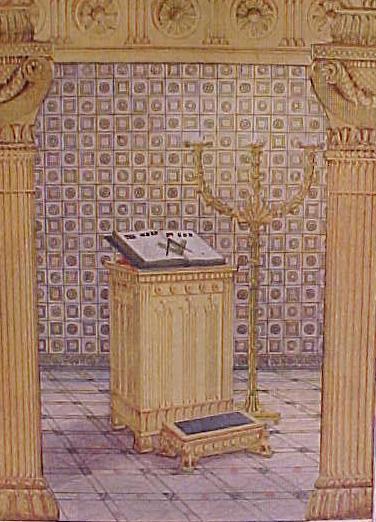
The Bible and the Temple
The Bible is many centuries old, but as a literal force in the
life of western Christianity it began to grow only with the invention of
printing and the success of the Reformation. Its growth as the Great Light in
Masonic Lodges paralleled its growth in the churches and in the homes of pious
men. Masons, like other people, took up the reading of the Bible as soon as it
was translated out of the Latin and printed in sufficient quantities to bring
it within reach. Always present in the Lodge for the swearing of candidates, it
became increasingly important in the minds and lives of its readers. Masons
became aware of the Biblical source of many of their Legends, and perhaps became
inclined to attribute Biblical significance to legends which originally had
none. At any rate they could see that the fundamental precepts of Masonic
morality were actually to be found in the Volume of Sacred Law. They saw also
that King Solomon's Temple occupied a prominent place in divine as it did in
Masonic history. The growth of popular interest in the Temple paralleled very
closely the growth of Bible reading. Perhaps Masonic interest also increased
from a more or less incidental notice of the Temple to a final preoccupation
with it as a symbol of spiritual man. The Bible hardly came into its own as a
widely read book until after the publication of the King James version in 1611.
The Temple began to appear prominently in religious literature at about the same
time. Hugh Broughton, who died in 1612, left some writings on the Temple, as did
John Selden (1584-1654). Nicholas Fuller referred to it in a book published at
Heidelberg in 1612 and at Oxford in 1616. Christopher Cartwright (1602-1658) had
a good deal to say about the Temple in his writings on the Talmud. Samuel Lee,
in 1659, published a very suggestive work: Orbis Miraculum, or the Temple of
Solomon, Portrayed by Scripture-light . . .
Models of the Temple
Late in the 17th century there were several attempts to create
models of King Solomon's Temple. Some of them attracted wide notice in England
at just the time the operative Masonic craft was being gradually transformed
into what we know as speculative Freemasonry. Gottfried Hensel, rector of
Hirschberg in Germany, made a model. Rabbi Jacob Jehuda Leon was displaying one
in England in 1675. A little later, Gerhard Schott was building his in Hamburg.
This one was still being shown in London in 1725, eight years after the first
Grand Lodge was organized.
Solomon's Temple
Spiritualized
Even before the Apostle Paul, in his first letter to the
Corinthians, spoke of man as "the Temple of God," the idea of a spiritual temple
in the human soul has had religious currency. It was natural that Solomon's
great building should come to be regarded as the ideal prototype of such a
temple. It was natural, also, that this idea should be an integral part of the
first essay in which the word "Freemason" ever appeared in print. In The
Pilgrimage of Perfection, by William Boude (1526), the following appeared: "We
were but as apprentices bound to learn the craft of the exercise of virtues; and
now this day we shall be masters of the craft. Example. The free mason setteth
his apprentice first a long time to learn to hew stones, and when he can do that
perfectly, he admitteth him to be a free mason and chooseth him as a cunning man
to be master of the craft, and maketh him a setter or orderer of the same stone
. . . And so to build to Almighty God a glorious and pleasant temple in our
souls, we as the workmen, and He as the principal author and master of the work.
Now in diverse degrees, according to their exercise in grace, every person
buildeth in his soul a temple to God, some more some less, as the clearness of
their consciences requireth . . ." The next section of the book drew lessons
from the Tabernacle and Temple.
Antiquarians and Freemasons
Many non-operative members of Masonic lodges, the "speculative"
or "accepted" Freemasons, must have been interested in the Temple, as well as in
the cathedrals, now old, which the operative Masons had built. In the century
following the Reformation, the craft attracted philosophers, scientists, and
antiquaries, as well as gentlemen and soldiers. Elias Ashmole and Randle Holme
were two distinguished examples, and there is no doubt that several of the
original members of the Royal Society were Masons.
To these men, if not to the operative Masons generally, the
place of King Solomon's Temple in Masonic legend and symbolism must have become
increasingly important. They were interested in the Temple as Solomon actually
constructed it, and they were almost certainly interested in it also as a symbol
of man's struggle for perfection. Francis Bacon, who may or may not have had
direct connection with then existing Masonic organizations, wrote a few years
before 1626 a fable called The New Atlantis, an important feature of which was a
marvelous society known as "Solomon's House." This had nothing directly to do
with King Solomon's Temple, but it showed the disposition of learned men of the
17th century to associate any organized search for wisdom and truth with the
symbolism of the Temple which Solomon built in Jerusalem.
Grand Lodge Masonry
The exact position of the Temple and the Bible in operative and
early speculative Masonry is still in question. Enough has been shown to
indicate that both must have been of considerable importance. It is especially
evident that King Solomon's Temple, since it was attracting so much attention in
the world at large and among the class of men who became speculative Masons,
must in the 17th century have been one of the outstanding legends of the Craft.
Early in the 18th century (1717), four old Lodges in London met
together to form the first Grand Lodge, and Freemasonry was well on its way
toward becoming the organized fraternity which we know today. Probably as early
as 1720 or 1730, George Payne, John T. Desaguliers, and their associates had
developed a ritual of three degrees, with the legend of King Solomon's Temple
holding the central position. This legend, of which there were possible
suggestions in the earliest manuscripts, had grown to be one of the dominant
themes in Masonry.
Concerning God and Religion
Probably we should never know just how different or how similar
Grand Lodge Masonry may be to the operative and speculative Masonry that came
before it, but of one important change there is no doubt. The operative Masonry
of the Middle Ages, and also the increasingly speculative Craft of the 17th
century, were Christian and Trinitarian. In contrast, the first Charge in the
Grand Lodge Book of Constitutions, 1723, was as follows: "A Mason is obliged by
his Tenure, to obey the moral Law; and if he rightly understands the Art, he
will never be a stupid Atheist, nor an irreligious Libertine. But though in
ancient time Masons were charged in every Country to be of the Religion of that
Country or Nation, whatever it was, yet 'tis now thought more expedient only to
oblige them to that Religion in which all men agree, leaving their particular
opinions to themselves; that is, to be good Men and true, or men of Honor and
Honesty, by whatever Denominations or Persuasions they may be distinguished;
whereby Masonry becomes the center of Union, and the means of conciliating true
Friendship among Persons that must else have remained at a perpetual distance."
Still deeply religious, Masonry had become universal.
Important as the Bible undoubtedly was in early speculative
Masonry, its dominant position became more rather than less pronounced after the
organization of Grand Lodges in the 18th century. Although this first charge
Concerning God and Religion in the Grand Lodge Book of Constitutions does not
specifically mention the Bible, the implication is that its immemorial status as
an essential part of the Lodge was well understood, and was to remain unchanged.
A little later, when printed references to Masonry became more plentiful, the
Bible appeared prominently in them. As early as 1730, the Bible, Square, and
Compasses were mentioned in London as "furniture of the Lodge." According to The
Boston Evening Post, June 20, 1743, reporting an incident in Vienna, a Lodge
there had "a Bible on the table, open at the first chapter of Genesis." In
Helston, Cornwall, April 21, 1752, a Brother Issac Head delivered a Charge: ". .
. Let our whole deportment testify for us that we have formed our lives upon the
perfect model of God's revealed will, exhibited to us in the Holy Bible; that
this Book is the basis of all our Craft, and that it is by this piece of Divine
furniture, so essential to our society, we are taught wisdom, to contrive in all
our doings. . ." The Bible is now so closely identified with the Lodge that, for
Christian countries, it is one of the very few undisputed Landmarks of
Freemasonry. Another is belief in God. These two essentials, belief in a Supreme
Being and reverence for His Word, establish beyond question the character of the
Fraternity.
How the Pictures were
Obtained
It is known to every reader of the Bible and student of
Solomon's days, that an amazingly detailed description of the Temple and its
associated structures has been carried down from the mists of antiquity by the
Scriptures. Lineal measurements, materials employed, and ornamental detail are
so graphically presented that restoration of the Temple, at any time within a
score of centuries past, awaited only the coming of a man with the vision to
recognize its historic value, and the imagination to undertake the task.
Notwithstanding the universal interest in King Solomon's Temple, -- a
fascination which has created innumerable legends and romances during the
intervening centuries -- the incredible fact remains that no scientific effort
to restore the Temple was made until John Wesley Kelchner, Archaeologist, Bible
Student and Lecturer began eighty years ago to make real his vision of the
Scriptural description. His personal fortune went freely into the world-wide
search for archaeological data and period decorative technique, from which to
render accurately, down to the minutest detail, the ornamental scheme revealed
by the Biblical story. Other noted archaeologists collaborated with Dr. Kelchner,
and at length the work was completed. In 1923 Dr. Kelchner had assembled all
that was needed to erect an exact replica of a Temple which had vanished 3,000
years ago.
The next step was to display the entire conception, from the
foundation up, in graphic sketches, paintings, working drawings and plans. In
his New York studio, he surrounded himself with expert draftsmen and capable
artists, laying before them the models, plans and designs of this, his life
work. As Moses after receiving the Designs of the Tabernacle of Israel called to
his aid the "cunning" master mechanic, Bezaleel, who was "filled with the spirit
of God in wisdom, in understanding and in knowledge, and in all manner of
workmanship," and as Solomon "sent and fetched Hiram out of Tyre," filled with
wisdom and understanding, and a cunning skilled workman, so did John Wesley
Kelchner labor with these experts. Together they dropped out of the Twentieth
Century, back into the years 1011-1004 Before Christ. The difference was only
thirty centuries between; the creative objective the same; and the results
identical.
Now the art of our period is enriched by a set of paintings and
drawings of unparalleled historical value. Nothing so marvelous of its kind has
ever been achieved for the illustration of any subject. The paintings and
drawings were prepared by the ablest artists of their field in America and
Europe. They translate to the layman's vision the architect's technical plans as
worked out in modern builders' specifications.
back to top |
![]()























